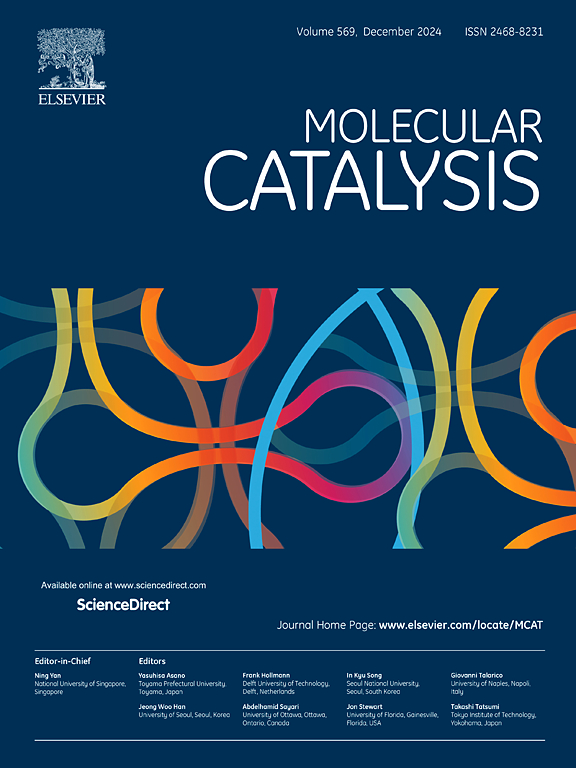通过 DFT 计算确定 TiO2 对支撑 Ru 单原子催化剂 CO2 甲烷化的带隙效应
IF 4.9
2区 化学
Q2 CHEMISTRY, PHYSICAL
引用次数: 0
摘要
利用 Ru1/2L-TiO2 和 Ru1/3L-TiO2 作为二氧化碳甲烷化的模型催化剂,通过密度泛函理论计算研究了 TiO2 带隙对支撑单钌 (Ru1) 原子的结构和反应活性的影响。这两种载体的带隙分别为 2.39 eV 和 1.48 eV。带隙在电子金属-载体相互作用(EMSIs)和 TiO2 上 Ru1 的 d 带中心位置中起着重要作用。与 Ru1/2L-TiO2 相比,Ru1/3L-TiO2(Ru1 支撑在带隙较窄的 3L-TiO2 上的 Ru1 催化剂)显示出更强的电子金属-支撑相互作用(EMSIs)和更远离费米级的 d 带中心位置,导致 Ru1 上的电荷密度更低,对 H2、CO2 和 CO 的吸附更弱。CO2 甲烷化遵循 CO 路径,在 Ru1/nL-TiO2 上,CO* 加氢为 HCO* 是决定速率的步骤。尽管带隙不会改变反应途径,但在带隙较窄的 TiO2 上支撑的 Ru1 催化剂在动力学和热力学上更有利于 CO2 甲烷化。较窄的带隙支撑增强了氢的流动性,氢对 CO 的吸附具有明显的促进作用,这些都是 Ru1/3L-TiO2 上 CO* 更容易加氢的关键因素。本文章由计算机程序翻译,如有差异,请以英文原文为准。
Band gap effect of TiO2 on supported Ru single-atom catalysts for CO2 methanation by DFT calculations
The influence of TiO2 band gap on structure and reactivity of the supported single ruthenium (Ru1) atom was studied by density functional theory calculations, utilizing Ru1/2L-TiO2 and Ru1/3L-TiO2 as model catalysts for CO2 methanation. The supports have band gaps of 2.39 eV and 1.48 eV, respectively. The band gap plays a significant role in electronic metal-support interactions (EMSIs) and the position of the d-band center of the Ru1 on the TiO2. The Ru1/3L-TiO2, the Ru1 catalyst supported on the 3L-TiO2 with a narrower band gap, shows enhanced EMSIs and a d-band center that is positioned farther from Fermi level, leading to lower charge density on the Ru1 and weaker adsorption of H2, CO2, and CO compared to the Ru1/2L-TiO2. CO2 methanation followed CO pathway, with the hydrogenation of CO* to HCO* identified as the rate-determining step on the Ru1/nL-TiO2. The Ru1 catalyst supported on TiO2 with a narrower band gap is more favorable kinetically and thermodynamically for CO2 methanation, despite the band gap not altering the reaction pathway. Enhanced hydrogen mobility and a pronounced promotional effect of hydrogen on CO adsorption, due to the narrower band gap support, are key factors facilitating the easier hydrogenation of CO* on the Ru1/3L-TiO2.
求助全文
通过发布文献求助,成功后即可免费获取论文全文。
去求助
来源期刊

Molecular Catalysis
Chemical Engineering-Process Chemistry and Technology
CiteScore
6.90
自引率
10.90%
发文量
700
审稿时长
40 days
期刊介绍:
Molecular Catalysis publishes full papers that are original, rigorous, and scholarly contributions examining the molecular and atomic aspects of catalytic activation and reaction mechanisms. The fields covered are:
Heterogeneous catalysis including immobilized molecular catalysts
Homogeneous catalysis including organocatalysis, organometallic catalysis and biocatalysis
Photo- and electrochemistry
Theoretical aspects of catalysis analyzed by computational methods
 求助内容:
求助内容: 应助结果提醒方式:
应助结果提醒方式:


